A Finite Difference Scheme for Compressible Miscible Displacement Flow in Porous Media on Grids with Local Refinement in Time
Abstract
Considering two-dimensional compressible miscible displacement flow in porous media, finite difference schemes on grids with local refinement in time are constructed and studied. The construction utilizes a modified upwind approximation and linear interpolation at the slave nodes. Error analysis is presented in the maximum norm and numerical examples illustrating the theory are given.
1. Introduction
Numerical models of percolation flow are almost built up on a basis of the finite difference method to solve the system of partial differential equations. Usually, grids that we used are thinner, then the truncation error is smaller and the computing accuracy is higher. In order to assure certain computation accuracy, the grid number cannot be too little. But on the other hand, along with the increment of the grid number, the computation cost is greatly increased and the algebraic system which is formed finally cannot be resolved, even with the largest of today’s supercomputers. Actually, we only need to refine grids around wells, cracks, obstacles, domain boundaries, and so forth, where the pressure changes radically. But because the finite difference grid is composed of straight lines and the grid density cannot be varied with space, it limits the simulating scale and the simulating accuracy. For the local grid refinement technique, we still make use of the finite difference grid system and divide partial grids which are needed to be refined into fine grids. In this way, we can resolve problems, such as small well spacing, fault, and boundary, and we can improve the simulating accuracy and extend the simulating scale [1].
Ewing et al. construct some finite difference approximations on grids with local refinement in space for the ellipse equation and obtain error estimates in the H1-norm [2]. Cai et al. analyze stationary local grid refinement for the diffusion equation [3, 4]. Ewing et al. derive implicit schemes on the basis of a finite volume approach by approximation of the balance equation. This approach leads to schemes that are locally conservative and are absolutely stable [5]. Ewing et al. construct and study finite difference schemes for transient convection-diffusion problems on grids with local refinement in time and space. The proposed schemes are unconditionally stable and use linear interpolation along the interface [6]. Respectively for incompressible miscible displacement flow in porous media and the semiconductor device problem, authors discuss discrete schemes, error estimates, and numerical examples on composite triangular grids [7, 8].
In this paper, we study a finite difference scheme on grids with local refinement in time for two-dimensional compressible miscible displacement flow in porous media. The pressure equation is approximated by a five-point difference scheme, and the saturation equation is discretized by a modified upwind scheme. At the slave nodes, the construction utilizes linear interpolation. Finally, error analysis in the maximum norm is derived and numerical examples are given to support the numerical method and its convergence.
The paper is organized as follows. In Sections 2 and 3, we formulate the problem and introduce the necessary notations. In Section 4 the construction of the finite difference scheme is presented. The error analysis is addressed in Section 5. Finally, in Section 6 we present numerical experiments that conform our theoretical results.
2. Problem Formulation
3. Grids, Grid Functions, and Associated Notations
First, Ω = [0,1] 2 is discretized using a regular grid with a parameter h. The spatial nodes of the grid on Ω are then defined by x = (x1, x2) = (n1h, n2h), where n1 = 0, …, N, n2 = 0, …, N, h = 1/N. Next, we introduce closed domains , which are subsets of Ω with boundaries aligned with the spatial discretization already defined. Further, it is required that , and we set . In order to avoid unnecessary complications, for i, j > 0, we assume that dist(Ωi, Ωj) ≥ lh, where l > 1 is an integer.
With each subdomain Ωi, we associate corresponding sets of nodal points: ωi is defined to be the set of all nodes of the discretization of Ω that are in Ωi. We require ωi ⋂ ωj = ∅, for i ≠ j, i, j = 0, …, M. And assume that there is no spatial refinement. In each ωi, i = 0, …, M, we define a subset of boundary nodes γi as the nodes which have at least one neighbor not in ωi. Then set .
4. Construction of the Finite Difference Schemes
Let P, U, and C be the numerical approximations to the pressure p, the velocity u, and the saturation c, respectively. The approximation for the pressure and the concentration approximation are done on composite grids in time.
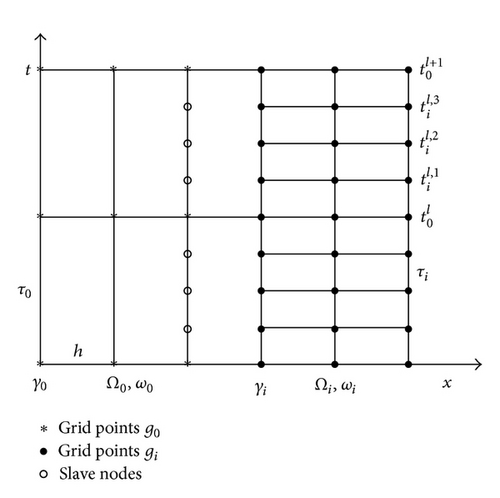
5. Error Analysis
Theorem 1. The finite difference schemes (23) comply with the requirements of the maximum principle and the difference operator is coercive in , that is, ∃μ > 0 such that
Lemma 2. and exist and are nonnegative, and the following estimates hold:
Theorem 3. Let the exact solutions c(x, t) of (1) satisfy the condition (6), then the discretization scheme (23) is stable, and if τ0 = O(h) the following estimate for the error holds:
Proof. Define
It remains to check (32) and the induction hypothesis (36) for . From τ0 = O(h) and the error estimate (40), it is easy to obtain (36). Then using (30) and (31), (34), and (40), we can obtain the supposition (32). The proof of Theorem 3 is complete.
6. Numerical Results
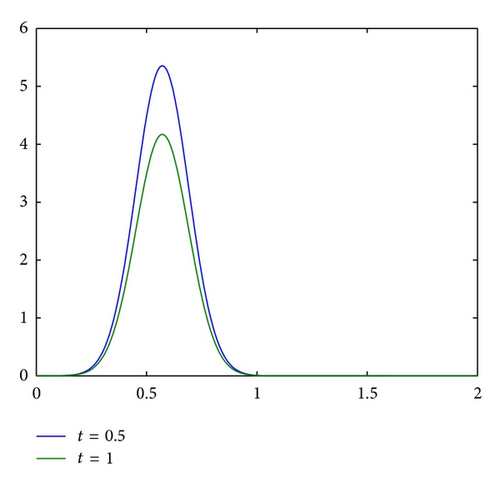
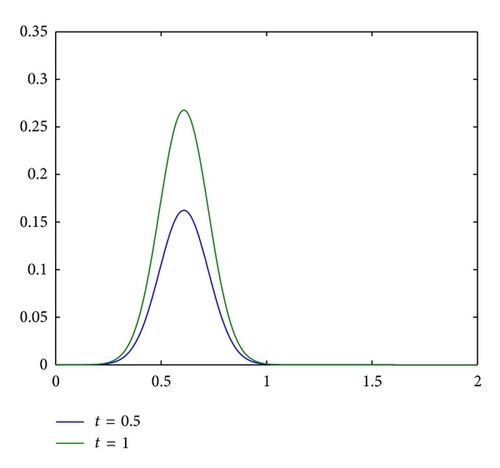
From Figures 2 and 3, we can see exact solutions of (47) possess highly localized properties in [0.2,1] 2. First, Ω is discretized using a regular grid. Let the space-step h = 1/160 and the time-step τ0 = h. Then choose the subregion Ω1 = [0,1.3] 2, which is refined in time. Let the discretization parameters τ′ = τ0/m in the refined region Ω1, where m is a positive integer. We denote by C the numerical approximation to c obtained by (23). And let the error estimate in maximum norm γ = maxg|c − C|.
Example 4. Let D(x) = 1. Choosing m = 1,2, 4,8, computational results obtained by (23) are shown in Figures 4 and 5 and Table 1.
| m | t = 0.5 | t = 1 | ||||
|---|---|---|---|---|---|---|
| Computational cost | γ | Reduction | Computational cost | γ | Reduction | |
| 1 | 0.1560 | 0.0159 | 0.3130 | 0.0356 | ||
| 2 | 0.5780 | 0.0062 | 2.56 | 1.1560 | 0.0137 | 2.60 |
| 4 | 2.3440 | 0.0026 | 2.38 | 4.6080 | 0.0058 | 2.36 |
| 8 | 9.2810 | 0.0012 | 2.17 | 18.6800 | 0.0026 | 2.23 |
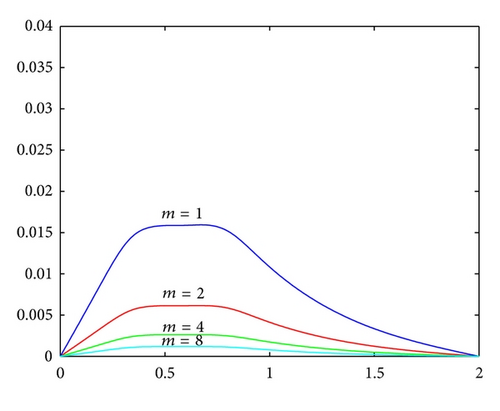
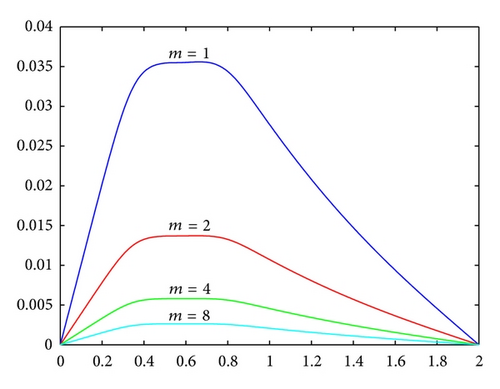
Example 5. Let D(x) = x. Choosing m = 1,2, 4,8, computational results obtained by (23) are shown in Table 2.
| m | t = 0.5 | t = 1 | ||||
|---|---|---|---|---|---|---|
| Computational cost | γ | Reduction | Computational cost | γ | Reduction | |
| 1 | 0.1710 | 0.0535 | 0.3270 | 0.1342 | ||
| 2 | 0.5920 | 0.0254 | 2.11 | 1.1680 | 0.0641 | 2.10 |
| 4 | 2.3840 | 0.0124 | 2.05 | 4.6590 | 0.0313 | 2.05 |
| 8 | 9.8810 | 0.0061 | 2.03 | 19.7440 | 0.0154 | 2.03 |
From Figures 4 and 5 and Tables 1 and 2, we can see that numerical results produced by using the local refinement technique are more accurate than those produced without refinement. From Tables 1 and 2, we observe a monotonic improvement of the accuracy in maximum norm when using difference refinement factors m. These results are of great importance for the research on numerical simulation of the fluid flow problem and also indicate that the method proposed in this paper can be widely applied to some application fields, such as energy numerical simulation and environmental science.
Acknowledgments
The author thanks Professor Yirang Yuan for his valuable constructive suggestions which lead to a significant improvement of this paper. This work is supported in part by the National Natural Science Foundation of China (Grant no. 71071088) and the Natural Science Foundation of Shandong Province of China (Grant no. ZR2011AQ021).




